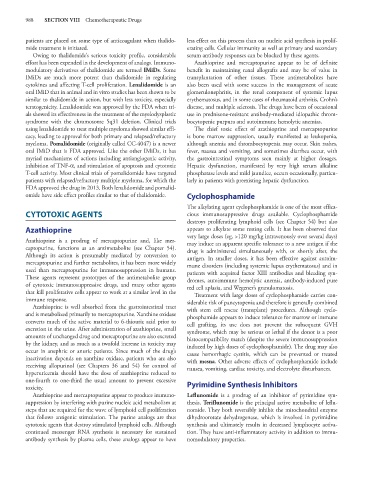Page 1002 - Basic _ Clinical Pharmacology ( PDFDrive )
P. 1002
988 SECTION VIII Chemotherapeutic Drugs
patients are placed on some type of anticoagulant when thalido- less effect on this process than on nucleic acid synthesis in prolif-
mide treatment is initiated. erating cells. Cellular immunity as well as primary and secondary
Owing to thalidomide’s serious toxicity profile, considerable serum antibody responses can be blocked by these agents.
effort has been expended in the development of analogs. Immuno- Azathioprine and mercaptopurine appear to be of definite
modulatory derivatives of thalidomide are termed IMiDs. Some benefit in maintaining renal allografts and may be of value in
IMiDs are much more potent than thalidomide in regulating transplantation of other tissues. These antimetabolites have
cytokines and affecting T-cell proliferation. Lenalidomide is an also been used with some success in the management of acute
oral IMiD that in animal and in vitro studies has been shown to be glomerulonephritis, in the renal component of systemic lupus
similar to thalidomide in action, but with less toxicity, especially erythematosus, and in some cases of rheumatoid arthritis, Crohn’s
teratogenicity. Lenalidomide was approved by the FDA when tri- disease, and multiple sclerosis. The drugs have been of occasional
als showed its effectiveness in the treatment of the myelodysplastic use in prednisone-resistant antibody-mediated idiopathic throm-
syndrome with the chromosome 5q31 deletion. Clinical trials bocytopenic purpura and autoimmune hemolytic anemias.
using lenalidomide to treat multiple myeloma showed similar effi- The chief toxic effect of azathioprine and mercaptopurine
cacy, leading to approval for both primary and relapsed/refractory is bone marrow suppression, usually manifested as leukopenia,
myeloma. Pomalidomide (originally called CC-4047) is a newer although anemia and thrombocytopenia may occur. Skin rashes,
oral IMiD that is FDA approved. Like the other IMiDs, it has fever, nausea and vomiting, and sometimes diarrhea occur, with
myriad mechanisms of actions including antiangiogenic activity, the gastrointestinal symptoms seen mainly at higher dosages.
inhibition of TNF-α, and stimulation of apoptosis and cytotoxic Hepatic dysfunction, manifested by very high serum alkaline
T-cell activity. Most clinical trials of pomalidomide have targeted phosphatase levels and mild jaundice, occurs occasionally, particu-
patients with relapsed/refractory multiple myeloma, for which the larly in patients with preexisting hepatic dysfunction.
FDA approved the drug in 2013. Both lenalidomide and pomalid-
omide have side effect profiles similar to that of thalidomide. Cyclophosphamide
The alkylating agent cyclophosphamide is one of the most effica-
CYTOTOXIC AGENTS cious immunosuppressive drugs available. Cyclophosphamide
destroys proliferating lymphoid cells (see Chapter 54) but also
Azathioprine appears to alkylate some resting cells. It has been observed that
very large doses (eg, >120 mg/kg intravenously over several days)
Azathioprine is a prodrug of mercaptopurine and, like mer- may induce an apparent specific tolerance to a new antigen if the
captopurine, functions as an antimetabolite (see Chapter 54). drug is administered simultaneously with, or shortly after, the
Although its action is presumably mediated by conversion to antigen. In smaller doses, it has been effective against autoim-
mercaptopurine and further metabolites, it has been more widely mune disorders (including systemic lupus erythematosus) and in
used than mercaptopurine for immunosuppression in humans. patients with acquired factor XIII antibodies and bleeding syn-
These agents represent prototypes of the antimetabolite group dromes, autoimmune hemolytic anemia, antibody-induced pure
of cytotoxic immunosuppressive drugs, and many other agents red cell aplasia, and Wegener’s granulomatosis.
that kill proliferative cells appear to work at a similar level in the Treatment with large doses of cyclophosphamide carries con-
immune response. siderable risk of pancytopenia and therefore is generally combined
Azathioprine is well absorbed from the gastrointestinal tract with stem cell rescue (transplant) procedures. Although cyclo-
and is metabolized primarily to mercaptopurine. Xanthine oxidase phosphamide appears to induce tolerance for marrow or immune
converts much of the active material to 6-thiouric acid prior to cell grafting, its use does not prevent the subsequent GVH
excretion in the urine. After administration of azathioprine, small syndrome, which may be serious or lethal if the donor is a poor
amounts of unchanged drug and mercaptopurine are also excreted histocompatibility match (despite the severe immunosuppression
by the kidney, and as much as a twofold increase in toxicity may induced by high doses of cyclophosphamide). The drug may also
occur in anephric or anuric patients. Since much of the drug’s cause hemorrhagic cystitis, which can be prevented or treated
inactivation depends on xanthine oxidase, patients who are also with mesna. Other adverse effects of cyclophosphamide include
receiving allopurinol (see Chapters 36 and 54) for control of nausea, vomiting, cardiac toxicity, and electrolyte disturbances.
hyperuricemia should have the dose of azathioprine reduced to
one-fourth to one-third the usual amount to prevent excessive Pyrimidine Synthesis Inhibitors
toxicity.
Azathioprine and mercaptopurine appear to produce immuno- Leflunomide is a prodrug of an inhibitor of pyrimidine syn-
suppression by interfering with purine nucleic acid metabolism at thesis. Teriflunomide is the principal active metabolite of leflu-
steps that are required for the wave of lymphoid cell proliferation nomide. They both reversibly inhibit the mitochondrial enzyme
that follows antigenic stimulation. The purine analogs are thus dihydroorotate dehydrogenase, which is involved in pyrimidine
cytotoxic agents that destroy stimulated lymphoid cells. Although synthesis and ultimately results in decreased lymphocyte activa-
continued messenger RNA synthesis is necessary for sustained tion. They have anti-inflammatory activity in addition to immu-
antibody synthesis by plasma cells, these analogs appear to have nomodulatory properties.

